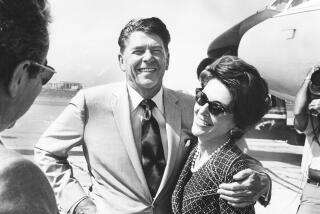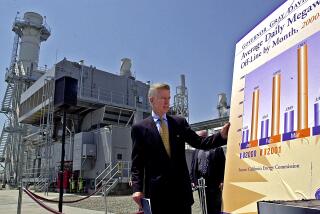RICHARD NIXON: 1913-1994 : Nixon’s Relations With California Ran Hot and Cold : History: The native son won House, Senate and White House jobs. But he had trouble winning respect at home.
In the boom days following World War II, veterans returning to California thought anything was possible, and a young Navy veteran named Richard Nixon seized the opportunity by running for Congress in 1946.
Thus began a turbulent political career spanning four decades during which Nixon and his native state shared an ambivalent relationship. California gave Dick Nixon stunning political success and humiliating defeat. And while Nixon--the only native Californian to become President--briefly sought refuge here after the disgrace of Watergate, he twice spurned his home state to live in New York and New Jersey.
In a sense, Richard Nixon was from California but not really of California.
Not only that, but “he was not of any other place,” observed Mervin Field, founder and director of the California Poll, and the state’s most veteran political analyst.
“He was so lonely, so insular, so isolated,” Field said.
Among California political figures, Nixon appeared to have few real friends or cronies, Field added.
He won seven elections here: 1946 and 1948 races for the House, 1950 for the U.S. Senate, 1952 and 1956 as Dwight D. Eisenhower’s vice presidential running mate, and 1968 and 1972 for the presidency.
But unlike most of the successful California politicians of his era--men like Republicans Earl Warren and Goodwin J. Knight and Democrat Edmund G. (Pat) Brown Sr.--Nixon was no glad-hander who was liked and admired from both sides of the partisan aisle.
Those who came to dislike Nixon got their revenge in 1962 when he lost his race for the governorship to Brown. Haggard, weary and unshaven, Nixon appeared before reporters the next morning to issue perhaps the most famous utterance in California political history: “You won’t have Nixon to kick around anymore because, gentlemen, this is my last press conference . . .”
It would be far from his last press conference, of course. In fact, it wasn’t even a press conference. Nixon strode into the meeting room on the seventh floor of the Beverly Hilton Hotel on that Nov. 5, delivered a 20-minute diatribe aimed mostly at the reporters themselves, and then stalked out without taking any questions.
From that day on, Nixon never seemed to be happy living in California, except for visits to the Western White House at San Clemente before his presidency began to crumble under Watergate. After the resignation, San Clemente became a place of self-imposed exile, former aides said, and in 1980 Nixon left California permanently.
As did most Americans, Californians mellowed in their feelings toward Nixon over the years. In a California Poll conducted several years back, a significant number of respondents thought Nixon merited appointment as a special ambassador or presidential counselor, pollster Field said Saturday. Beyond that, they drew the line: They did not want him to run for any public office again.
The story of Richard Nixon and California comes full circle Tuesday when his remains are flown west in a presidential jet to lie in state at the Nixon Library in the town of his birth, Yorba Linda. He will be buried on the library grounds Wednesday, next to the grave of his wife, Pat.
The obituaries will focus on his achievements as a world leader. But a small group of aging California politicians still feels the enmity seared into their public psyches by Nixon going back to his very first campaign against popular U.S. Rep. Jerry Voorhis, a five-term Democrat.
Like many of his contemporaries, Nixon launched his career in 1946 with help from political kingmakers who often decided who should run for what office and when.
Nixon was virtually unknown and without campaign resources when he entered the contest against Voorhis. One day, however, the wife of a prominent and wealthy Los Angeles-area Republican leader, Asa Call, attended a candidate forum in Whittier, Nixon’s other home town. She went home to tell her husband that Nixon was a comer and worthy of help, Call later related.
And he got help. Murray Chotiner, a campaign strategist whose major role was working for U.S. Sen. William F. Knowland, was delegated to advise Nixon on a part-time basis.
With Chotiner, whose name became synonymous with political tricksterism, Nixon perfected the modern negative campaign in California. He exploited the people’s fears of communism to question the loyalty of his Democratic foes.
During his successful race against Voorhis, Nixon followed Chotiner’s advice and ran a “high risk” campaign, charging in a debate that a labor organization which had endorsed Voorhis was infiltrated by Communists and fellow travelers.
At the same time, Nixon came to the attention of Kyle Palmer, political editor of The Los Angeles Times, then a bastion of Republican conservatism. Legend has it that Palmer was a virtual right hand of the Republican Party in California, with the power to make or break GOP aspirants.
After winning reelection in 1948, Nixon began making preparations for a run for the U.S. Senate in 1950 against Helen Mary Gahagan Douglas, a popular actress then also serving in the House. The relative significance of Palmer’s role in the making of Richard Nixon is debated to this day. But one comment in Nixon’s memoirs about the 1950 Senate campaign gives credence to the legend.
“During the fall (of 1949),” Nixon wrote, “I learned from Kyle Palmer, the astute political editor of the Los Angeles Times, that if I became a candidate for the Senate I would be endorsed by the Times. I received similar assurances about the San Francisco Chronicle and the Oakland Tribune.
“These endorsements were vital not only for the boost they would give my candidacy but because they would virtually assure that I would not face any opposition in the Republican primary.”
UC Berkeley political science professor Eugene Lee observed this past week: “It was a different kind of California politics.”
Long before the television-dominated campaigns of today, newspaper endorsements were, indeed, critical, and The Times, the Chronicle and Tribune were particularly influential.
The Times shed its reputation for favoritism to Republicans after Otis Chandler became publisher in 1960. Today, no reputable newspaper would advise a candidate beforehand whether he or she was going to get its endorsement.
The 1950 campaign, in Nixon’s words, was “one of the most hectic and heated campaigns of my career.”
Nixon issued a flyer printed on pink paper listing congressional votes by Douglas that were, Nixon said, similar to those of the only avowedly pro-communist member of Congress. More than 20 years before Watergate, Douglas tagged him as “Tricky Dick.” The name stuck, but Douglas’ political career ended.
Nixon defended himself in his memoirs with a statement that has become standard in negative campaigns today: He was not attacking Douglas personally, or her character. He was merely citing her voting record.
“The subsequently controversial ‘pink sheet’ that my committee issued was, in fact, inspired by . . . comparisons of the two voting records. Whatever interpretation was later placed on these facts, no one was ever able to challenge their accuracy. All we added was the mordant comment of the color of the paper.”
Field said that Douglas probably would not have won anyway but that “any chance she might have had was just obliterated by the no-holds-barred soft-on-communism attack.”
Nixon’s political ambition caught up with him in his attempt to wrest the governorship from Pat Brown in 1962, two years after Nixon narrowly lost the presidency to John F. Kennedy (Nixon carried California by an electoral whisker).
Political experts give a variety of reasons for Brown’s victory: He was a bumbler, but a popular one; the Cuban missile crisis of October pushed the election campaign into the background just as Nixon was beginning to chip away at Brown’s lead in the polls (Brown suspended his campaign and went to Washington for civil defense briefings), and that Nixon focused too much on national and foreign affairs rather than state issues.
“We knew that he didn’t give a damn about California,” said one veteran of the Brown campaign who asked not to be identified by name. “We talked California until he couldn’t stand it anymore.”
And Brown forces claimed that Nixon only wanted the California governorship to maintain a political base for his next race, for the presidency.
Nixon said pressure on him to run for governor began almost from the day he returned to California after losing to Kennedy and completing his second term as vice president. His intuition told him “it would be a case of running for the wrong office at the wrong time.”
But in his memoirs, published in 1978, Nixon said he decided to make the plunge after he was told by an influential adviser: “Either you run or you’re finished in national politics.”
When he finally announced for the governorship, in September of 1961, Nixon was running 13 points ahead of Brown in the California Poll.
By April, Brown had moved ahead by six points, and his poll lead stayed in that range right through the Nov. 4 balloting, which Brown won by a margin of 5 percentage points.
Field said his polling consistently showed that most of the factors now recited for Brown’s victory had little to do with the outcome. Nixon lost because a significant number of voters really suspected Nixon saw the governorship as a steppingstone to the White House.
“The dark side of the Nixon personality had been shown, and they turned on him,” Field said. “It wasn’t that Brown was able to turn it out. They started voting no on Nixon.”
Time would tell: The voters basically were correct.
And, Nixon wrote: “The real problem was that I had no great desire to be governor of California.”
In the famous press conference, his bitterness about the newspaper coverage of his campaign spilled out, mostly aimed at one of the two Los Angeles Times reporter who covered it. The Kyle Palmer era had passed.
Nixon said The Times had reported his own flub of saying he was running for governor of the United States but did not report a miscue of Brown’s.
“I think that it is time that our great newspapers have at least the same objectivity, the same fullness of coverage, that television has,” Nixon added. “And I can only say, Thank God for television and radio for keeping the newspapers a little more honest.”
The same edition of The Times carried a Page One statement by Publisher Chandler noting that The Times had supported Nixon in every one of his campaigns, including three editorials backing his candidacy for governor.
Just prior to the press conference, Nixon also got in a lick at his home state. While walking through the lobby en route to the session, he was heard to say: “Losing California after losing the presidency--well, it’s like being bitten by a mosquito after being bitten by a rattlesnake.”
After the election, a friend urged Nixon to move to New York because “now that I had lost the election, nothing tied me to California . . . and that I would find life there much more interesting and stimulating,” he said in his memoir.
By the following June, the Nixons were New Yorkers.
More to Read
Get the L.A. Times Politics newsletter
Deeply reported insights into legislation, politics and policy from Sacramento, Washington and beyond. In your inbox three times per week.
You may occasionally receive promotional content from the Los Angeles Times.










